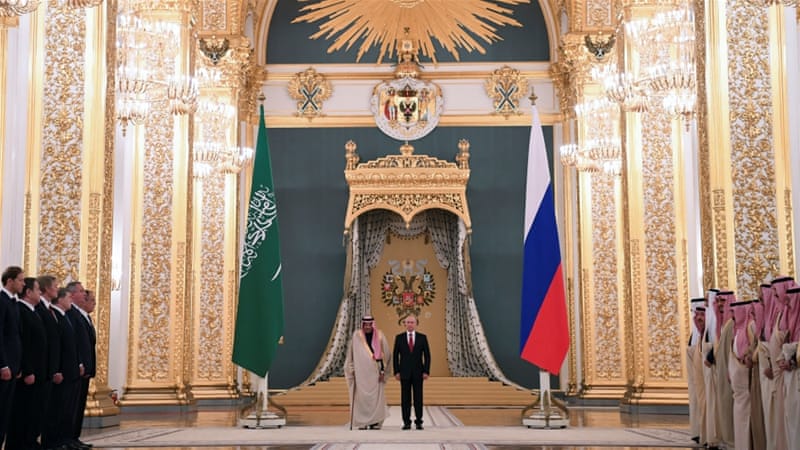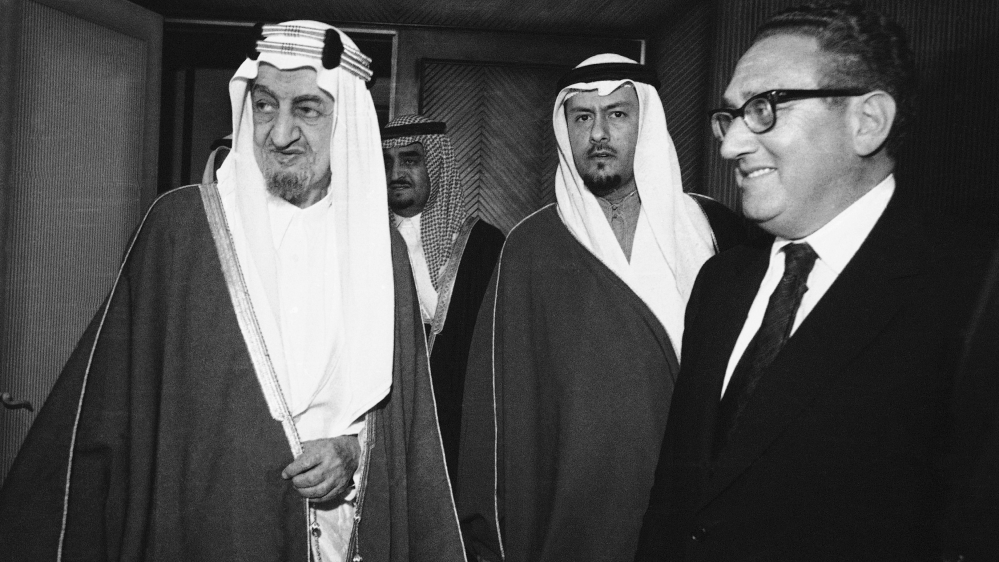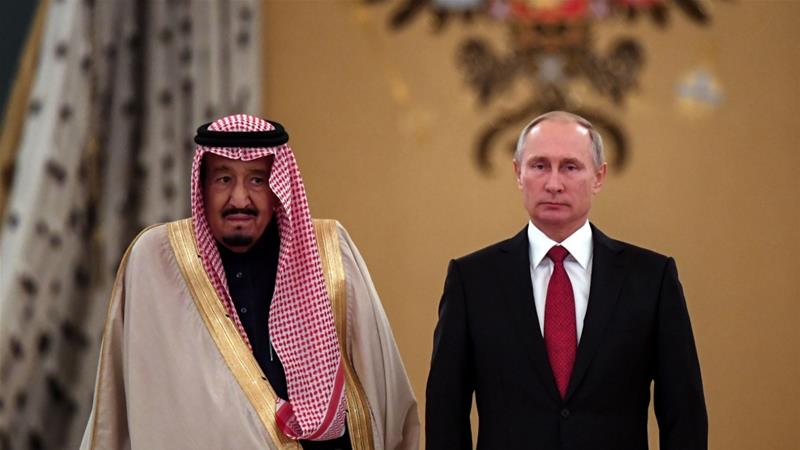
Last week, Saudi King Salman was greeted in Moscow with a lot of pomp and media attention. The 81-year-old monarch arrived with a 1,500-strong delegation amid high expectations for major political and trade deals.
The first visit of a Saudi king to Russia was rich in diplomatic courtesies, but it lacked in substance. What came out of the three days of meetings was much more modest than expected.
The two countries signed only a handful of agreements, most of which were memoranda of understanding. An agreement was reached to establish a $1bn energy investment fund and a $1bn hi-tech investment fund. The two sides also negotiated the sale of S-400 defence systems. But against the backdrop of the $15bn-worth of arms contracts the US recently approved for Saudi Arabia, the Moscow-Riyadh agreement seems quite modest. It very much seems like the high-level meetings in the Kremlin failed to create an appearance of a political and economic breakthrough in relations.
This shouldn't be all that surprising given that Russia and Saudi Arabia had a 54-year break in relations, during which the US became Riyadh's dominant partner and security guarantor. Perhaps the outcome of King Salman's visit could have been very different, if it weren't for an incident that spoiled Russian-Saudi relations 80 years ago and caused the break.
It is a little-known fact that Riyadh and Moscow used to enjoy remarkably warm relations in the 1920s and 30s. The Soviet Union was, in fact, a diplomatic pioneer in Saudi Arabia: It was the first state to recognise Abdulaziz Al Saud (King Salman's father) as the King of the Hijaz and the Sultan of Nejd in February 1926.
 |
| King Abdul Aziz Ibn Saud in 1930 [AP] |
The Soviet charm offensive in the Arabian Peninsula in the 1920s was the culmination of numerous attempts by Moscow to gain a foothold in the region prior to that. As early as 1900, Russian imperial military vessels started frequenting the Gulf and making port calls in Kuwait among other destinations. The famous Russian Varyag cruiser visited Kuwait in December 1901 and its captain was greeted by Emir Mubarak Al Sabah despite his agreement with Great Britain not to receive foreign military guests. It was during this visit that the Russians were first introduced to Abdul Rahman Al Saud who was exiled in Kuwait at that time, along with his elder son Abdulaziz, who a year later retook Riaydh from their rivals, the House of Rashid.
As the House of Al Saud was seeking international backing, London looked at young Abdulaziz with a lot of scepticism, which is why he came in contact with the Russian consul in the Persian city of Bushehr inviting him for a visit. The consul visited Kuwait in 1903 accompanied by a Russian military vessel, which caused an outcry in London.
But it wasn't until after the Bolshevik revolution that Moscow decided to seriously focus on the Gulf. Just like the Russian Empire, the Soviet Union saw the value of diplomatic presence in the region as a way to stand up to Britain.
Apart from pursuing relations with the House of Al Saud, the Soviet Union looked at the Kingdom of Hejaz whose ruler Sharif Hussein controlled Mecca and Medina as a way to reach out to the entire Muslim world. Being at odds with London, Hussein was on the lookout for strong foreign allies, which is why his representative in Rome engaged in talks with the Soviets.
 |
| Karim Hakimov in traditional Arab dress [Wikipedia] |
Extensive diplomatic communication between Georgy Chicherin, the Soviet People's commissar for foreign affairs, and Soviet diplomats reveals just how important his vision of the Arabian Peninsula and its role in the Muslim world was. Advocating the appointment of a Soviet Muslim as envoy to Hejaz, Chicherin noted in his memo to Joseph Stalin that "Getting into Mecca is of crucial importance to us because it would increase our influence in Arabia and beyond." He recognised that the annual pilgrimage to Mecca, the Hajj, was a perfect opportunity to reach out to thousands of Muslims from the British and French colonies and flare up anti-colonial sentiment.
In August 1924, Soviet Consul General Karim Khakimov, a Soviet Muslim of Tatar descent, arrived in Jeddah. Soon after Khakimov's arrival in Jeddah, Abdulaziz launched his campaign to take over Hejaz, which left newly arrived Soviet diplomats with a dilemma of whom to side with.
Diplomatic dispatches from the Soviet commissar for foreign affairs ordered Khakimov to position himself as an ally of all Arabs without openly showing a preference for either side. "If Ibn Saud pursues a policy of uniting the Arabs, this will be in our interests, and we will also have to try to get closer to him, as we did with respect to Hussein, who tried to unite Arabia," Chicherin wrote to Khakimov. The Soviet Union saw the unification of Arabs as the first step towards empowering Muslims in the region and undermining British rule over them.
By December 1924, Abdelaziz took Mecca and Khakimov was convinced that the time was right for him to try to introduce himself to Ibn Saud. In April 1925, when Jeddah was under siege, he was allowed to perform Umrah, a pilgrimage to Mecca, where Ibn Saud was based, thus getting a chance to meet him - something that no Western non-Muslim diplomat had been allowed to do. Khakimov's letters to Moscow reveal that his meeting with Abdulaziz went exceptionally well and that even his idea of Soviet mediation between Hejaz and Nejd was perceived positively by Ibn Saud.
By the end of 1925, Ibn Saud controlled Jeddah, and in February 1926 he declared himself King of Hejaz and Sultan of Nejd. As soon as the Soviet mission learned the news, Khakimov did what ultimately earned him the respect and friendship of Ibn Saud. On February 16, Karim Khakimov drove his personal car mounted with a Soviet flag through gunfire from Jeddah to Ibn Saud's residence in the desert to hand over a formal note recognising his status as the king. The Soviet Union was the first state to recognise his new title. Abdulaziz responded with a letter thanking the Soviet Union for its neutrality during the war with Hussein and expressed readiness for "relations with the government of the USSR and its citizens".
Soviet-Saudi relations improved further when the Pan-Islamic Congress of Mecca was called in June 1926, whose objective was to resolve the dispute over Mecca and Medina. At the time, Ibn Saud's control over these holy sights had many opponents among Islamic notables, which is why it was paramount for the king to earn recognition at the congress.
 |
| Karim Khakimov and Emir Faisal in Moscow in 1932 [Wikipedia] |
Realising this, the Soviet Union did what contradicted the fundamentals of its atheistic ideology: it sent six Soviet Islamic scholars to take part in the congress. Moscow with its 30 million Soviet Muslims threw its weight behind King Abdulaziz, providing the votes for him to be elected the president of the congress. What is more, as a result of Khakimov's efforts, a Soviet delegate was elected the vice-president of the conference. Having established full diplomatic relations with King Abdulaziz, the Soviet Union dispatched, in 1928, a new head of mission to the kingdom, Nazir Bey Turyakulov.
London's key concern about the Soviet influence in Jeddah was that it was spreading Communist propaganda among Muslims during the Hajj. Indeed, this was one of the ideas that Moscow had for its diplomats in Jeddah, but in reality, the Soviet mission had a hard time reaching out to both locals and pilgrims.
Faced with a lot of resistance, Soviet diplomats decided to focus on the creation of trade links between Soviet Black Sea ports and Hejaz. Khakimov managed to convince King Abdulaziz to lift restrictions against Soviet goods that existed in the kingdom due to London's lobbying. In 1929-1930, Soviet goods poured into the kingdom from the port city of Odessa. The biggest achievement of Soviet diplomats in Jeddah was entering the kerosene and benzine market that was almost entirely dominated by the British. The Soviet Union also sent a group of medics to the kingdom to take care of pilgrims during the Hajj.
As a result of Khakimov's efforts to further develop his ties with Ibn Saud, his son Prince Faisal (who became king in 1969) visited the Soviet Union during his extensive European trip in 1932. Moscow went out of its way to impress Faisal and his entourage by introducing them to the achievements of the Soviet industry, forgiving the Saudi debt that had accumulated by then and, most importantly, offering one million British pounds in financial aid that King Abdulaziz badly needed. While visiting Soviet Azerbaijan, what was going through an oil boom of its own, Prince Faisal was impressed with the country's oil industry expressing a desire to employ the same technology in the kingdom.
 |
| King Faisal meets US Secretary of State Henry Kissinger in Riyadh on March 19, 1975 [AP] |
The 1932 visit to the Soviet Union was the highlight of the Saudi-Soviet relations. King Abdulaziz used Moscow's offer of financial aid to push London to provide aid and never accepted the USSR's offer. From that point on, the relations between the two states stagnated. As the power of Joseph Stalin was growing stronger, the relationship between the communist regime and Islam was becoming uneasy. In 1932, the Soviet Union unofficially banned its Muslims from performing Hajj.
Soviet medics continued to work in the kingdom and the diplomatic mission continued to function spreading Soviet propaganda among Saudis. In 1937, the wife of the Soviet consul, a doctor herself, even stayed with the favourite wife of Prince Faisal for several months.
After spending a few years in Yemen and Moscow, Karim Khakimov returned to Jeddah as the Head of Mission in 1935, hoping to revitalise the relationship that during his absence gradually came to a halt. Khakimov tried negotiating new trade contracts with the king, but Moscow was no longer interested. It was the time when Hitler was growing stronger in Europe and Stalin, who was sceptical about the USSR's presence in the Gulf from the beginning, no longer saw the partnership with King Abdulaziz as beneficial. In fact, dropping any political ambitions for the Gulf was a gesture that Moscow thought would help it partner with England, whose support the Soviet Union sought against Hitler.
The career of the Soviet Lawrence of Arabia ended abruptly when he fell victim to Stalin's political terror in 1937. In September that year, he was recalled to Moscow for a routine visit to the foreign ministry, but upon his arrival, he was arrested on suspicion of being a spy. His colleague Turyakulov who worked with him on the Saudi file was executed in October 1937. Khakimov was executed in January 1938.
King Abdulaziz was outraged at the news that the two Soviet diplomats whom he considered his friends were killed. Two months after Khakimov was executed in Moscow, American geologists discovered the world's largest deposits of crude oil in Dhahran. This prompted the Soviet Union to appoint a new head of mission in Jeddah in 1938. King Abdulaziz, however, turned the appointment down saying that he does not wish to see anyone other than Khakimov or Turyakulov in Jeddah. He accused Moscow of inciting a revolution in the Muslim world and broke diplomatic ties with the Soviet Union. In September 1938, all remaining Soviet diplomats left Jeddah and the mission was shut down. With the USSR eliminated as a rival, Britain and later the US took over the development and exploitation of Saudi oil.
Relations between Russia and Saudi Arabia were fully restored only in 1992 after the collapse of the Soviet Union. It has been 25 years since then and Russian-Saudi relations have not developed beyond symbolic visits. Karim Khakimov's diplomatic efforts to create strong and lasting ties between Moscow and Riyadh remain unparalleled.
The views expressed in this article are the authors' own and do not necessarily reflect Al Jazeera's editorial policy.



No comments:
Post a Comment